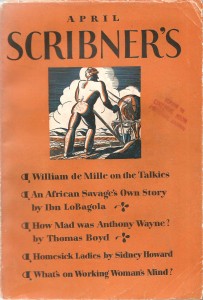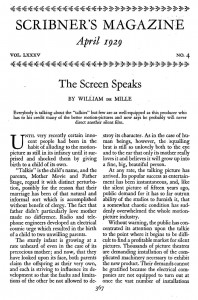Follow Scott
Recent Tweets
- Waiting for Twitter... Once Twitter is ready they will display my Tweets again.
Latest Photos
Search
Tags
anniversary Balticon birthdays Bryan Voltaggio Capclave comics Cons context-free comic book panel conventions DC Comics dreams Eating the Fantastic food garden horror Irene Vartanoff Len Wein Man v. Food Marie Severin Marvel Comics My Father my writing Nebula Awards Next restaurant obituaries old magazines Paris Review Readercon rejection slips San Diego Comic-Con Scarecrow science fiction Science Fiction Age Sharon Moody Stan Lee Stoker Awards StokerCon Superman ukulele Video Why Not Say What Happened Worldcon World Fantasy Convention World Horror Convention zombies
©2025 Scott Edelman
The Sound and the Fury
Posted by: Scott
Tags:
old magazines
Posted date:
February 7, 2008 |
No comment
Singing in the Rain has always been one of my favorite movies, and not just because of the talented stars and amazing songs (though, of course, that’s the major reason). But I think some small part of the film’s intrigue is because it’s one of the few films detailing the painful transition as one art form supplants another. I don’t see that sort of picture happening again any time soon. I mean, how likely is it that someone’s going to write a movie musical someday about the current battle between paper books and e-books?
Singing in the Rain told the story of the Talkies taking over the screen from a distance of 1952. But what did people think at the time it was actually happening? An article in the April 1929 issue of Scribner’s gives some clues. To lay out the time frame, The Jazz Singer, starring Al Jolson, premiered on October 6, 1927, at least in the big cities, though it took around six months to be seen by the rest of the country. Based on that, and on the lead time the magazine would have required, the essay “The Screen Speaks” by William de Mille would have been written during that first uncertain year.
William de Mille was the older brother of Cecil B. DeMille and father to Agnes de Mille. He was a silent film writer, director, and producer who, according to the editorial note at the beginning of the article, “says that he will probably never direct another silent film.” So his insight into the shift is invaluable.
The two most fascinating parts of the article for me are, first, an explanation of a term I’d never heard before, and then, a prediction of the steps the new art form would have to go through during its initial growth. First, the definition of the sort of film classified as a “goat gland”:
A “goat gland,” be it known, is a picture created as a silent film, into which is forcibly, and sometimes painfully, injected one or two “talking sequences” to give the poor thing strength enough to face a world howling for pictures which are audible in some way or another. The “goat gland,” however, will probably not long survive as an acceptable form. Characters which talk part of the time and are stricken dumb the rest of the time are too difficult to accept as real people. It has always been difficult for an audience to swap conventions in the middle of a scene, and once a character shows he can talk he must continue or seem “dumb” indeed. The convention which underlies the silent picture was only binding while it was known to be necessary.
For all I know, I’m the only one who’s never heard that term, but it was certainly new to me!
Then, near the end of the article, de Mille predicts the way in which the talking picture will grow:
The public, at present, is amazed to hear the screen talk, but in a very short time they will demand that it say something. It would not be surprising if the public were to go through the same progression with the talkie as happened in the case of its mother, the movie. This may be roughly sketched as follows:
1. A wild desire to see the new curiosity—pictures that moved; it mattered not what was shown.
2. The necessity of having pictures tell a story in order to maintain audience interest.
3. The discovery that the form was very crude.
4. The realization that they needed it anyhow.
5. With gradual improvement the demand for “bigger and better” pictures.
6. The demand for even better, though smaller, pictures.
7. The picture public’s growing appreciation of art.
8. Gradual freeing of the form through this appreciation.
Those who are closest, however, to the heart of the problem expect that this development will be much more rapid than it was with the movie.
I imagine that these are steps through which any art form must pass on its steps to acceptance. We saw it first with the talking picture, as laid out by de Mille, but then once again when color was introduced to the movies, followed by the same progression with television, then comic books, and currently video games. I don’t know what new art forms are waiting for us in the coming years, but they will probably have to go through the same stages as well.


